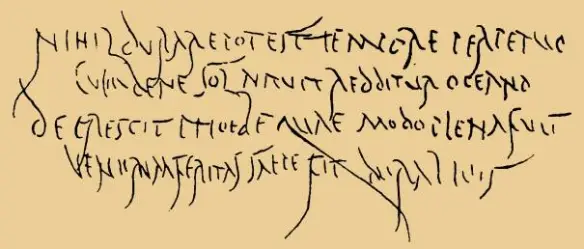Introduction
The ancient city of Pompeii, famously preserved under layers of volcanic ash from the eruption of Mount Vesuvius in AD 79, offers a remarkable glimpse into Roman life. Among the artifacts uncovered are inscriptions, ranging from official decrees to casual graffiti. These texts provide invaluable insights into everything from politics and social norms to personal sentiments and daily life. However, interpreting these inscriptions is not without its challenges. Various biases and problems, including preservation issues, sampling limitations, and interpretative challenges, can complicate efforts to reconstruct the past. Let’s delve into these complexities to understand how scholars approach the inscriptions of Pompeii.
1. Preservation Bias
The eruption of Mount Vesuvius ensured the survival of countless artifacts, but not all inscriptions have endured equally. The material used for inscriptions—stone, plaster, or even paint—played a significant role in their durability. Stone carvings, for example, are more likely to survive the test of time than graffiti painted on walls.
Furthermore, exposure to environmental elements during excavation or subsequent handling has led to the degradation of many inscriptions. Excavation methods, especially in earlier centuries, were often destructive, resulting in the loss or damage of some texts. These preservation biases mean that the inscriptions we study today represent only a fraction of what once existed, potentially skewing our understanding of Roman life.
2. Sampling Bias
The inscriptions that archaeologists have uncovered may not reflect the full spectrum of Pompeian society. Literacy in ancient Rome was not universal, and creating inscriptions required both literacy and access to materials, which were privileges typically afforded to wealthier or more educated individuals.
As a result, the majority of inscriptions may disproportionately represent the views, concerns, and expressions of the elite or literate classes. The perspectives of lower socioeconomic groups, including enslaved individuals or the illiterate majority, are likely underrepresented, leaving significant gaps in our understanding of their experiences and contributions to society.
3. Temporal Misinterpretation
Dating Pompeii’s inscriptions is another significant challenge. Some texts may have been created decades before the eruption of Mount Vesuvius, while others were likely added shortly before the disaster. Without precise dating methods, it becomes difficult to place these inscriptions in a chronological context.
This temporal ambiguity complicates efforts to connect inscriptions with specific historical events or social changes. For instance, political endorsements may reflect a long-past election rather than the political climate of AD 79, leading to potential misinterpretations of their significance.
4. Content Bias
The content of Pompeii’s inscriptions is another area where biases emerge. Certain topics, such as political campaigns, personal declarations, or romantic expressions, are more commonly found. These themes, while fascinating, may not represent the full range of societal concerns or daily activities.
For example, political endorsements inscribed on walls might indicate the popularity of certain candidates but reveal little about the broader political system. Similarly, graffiti expressing love or humor provides a glimpse into personal sentiments but leaves out economic, religious, or cultural aspects that were equally important in Roman life.
5. Modern Interpretation Challenges
Contemporary scholars face the additional challenge of interpreting ancient texts through a modern lens. It’s all too easy to project today’s cultural norms, values, or biases onto these inscriptions, leading to distorted understandings.
For example, modern ideas about love, humor, or politics may differ significantly from ancient Roman perspectives. Without careful context-based analysis, scholars risk misunderstanding the intent or significance of these inscriptions, potentially misrepresenting ancient Pompeian society.
6. Physical Alterations
Many inscriptions bear evidence of physical alterations, such as erasures, overwriting, or damage. In some cases, these changes were intentional, reflecting shifts in political allegiances, personal disputes, or efforts to repurpose a space. In other instances, alterations were unintentional, caused by wear and tear over time.
These changes complicate efforts to understand the original content and purpose of inscriptions. For example, a partially erased political endorsement might obscure the name of a candidate, leaving scholars guessing about the inscription’s original intent.
7. Strategies for Overcoming Biases
To mitigate these biases, scholars adopt a multidisciplinary approach. Archaeologists, historians, and linguists work together to piece together the context of inscriptions. Advances in technology, such as 3D imaging and chemical analysis, have also revolutionized the study of inscriptions, allowing researchers to recover faint or damaged texts.
By combining these methods with a cautious, context-aware mindset, scholars can gain a more nuanced understanding of Pompeii’s inscriptions and the society that created them.
8. Importance of Recognizing Biases
Despite these challenges, Pompeii’s inscriptions remain a treasure trove of information. Recognizing the biases and problems inherent in their interpretation is crucial for constructing a more accurate picture of ancient Roman life. These texts, though imperfect, offer a direct connection to the voices of the past, shedding light on the complexities of human experience in one of history’s most fascinating civilizations.
Conclusion
Pompeii’s inscriptions are windows into the world of ancient Rome, but they must be approached with caution. Preservation, sampling, and interpretative biases all influence how we understand these texts. By acknowledging these challenges and employing rigorous methodologies, scholars can continue to uncover the rich stories hidden within Pompeii’s walls. These inscriptions, despite their limitations, remain invaluable in illuminating the lives, thoughts, and aspirations of the people who once walked the city’s streets.
FAQs
- What types of inscriptions were found in Pompeii?
Inscriptions range from official decrees and political endorsements to graffiti expressing personal sentiments, advertisements, and even jokes. - Why is preservation bias a concern for Pompeii’s inscriptions?
Many inscriptions have been lost or damaged due to material fragility, environmental exposure, and early excavation methods, limiting the range of available texts. - How do scholars address the challenges of sampling bias?
Scholars use contextual evidence and multidisciplinary approaches to account for underrepresented groups, such as the lower socioeconomic classes. - What tools help in studying damaged inscriptions?
Modern technologies like 3D imaging and chemical analysis are used to recover and analyze faint or altered inscriptions. - Why are Pompeii’s inscriptions important despite their biases?
They provide a rare and direct glimpse into Roman life, offering insights into everything from politics and culture to personal relationships.


Thanks for sharing. I read many of your blog posts, cool, your blog is very good.